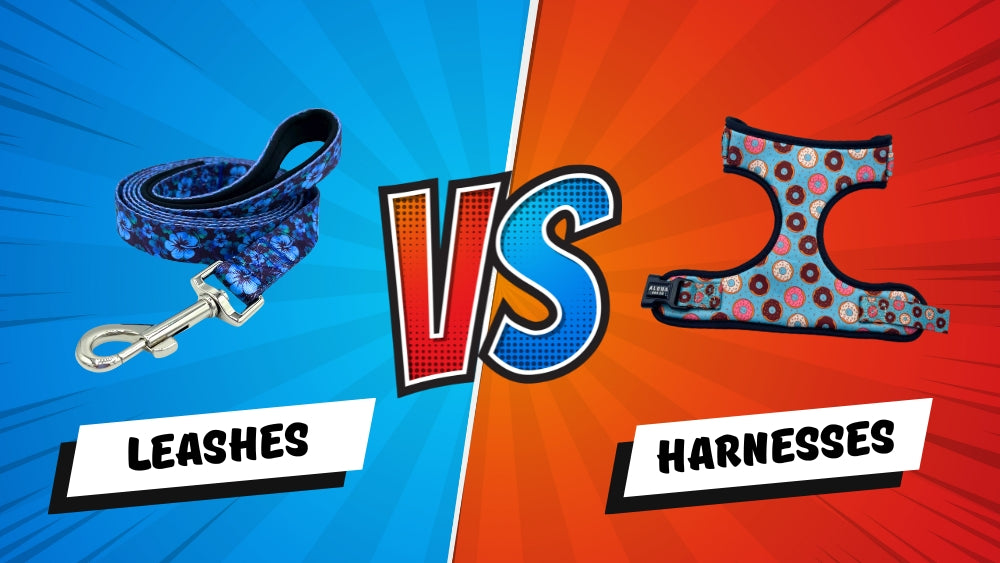
Dog Leashes vs. Harnesses: Choosing the Right Gear for Your Canine Companion
Share
When it comes to walking your dog, choosing between a leash and a harness can be a significant decision. Both options serve the purpose of keeping your furry friend under control, but they come with distinct advantages and considerations. In this blog, we will explore the differences between dog leashes and harnesses, helping you make an informed choice that ensures your dog's safety, comfort, and enjoyment during walks.
The Leash Advantage:
A dog leash is a fundamental tool for walking and controlling your dog. It attaches to your dog's collar, allowing you to guide their movements and ensure they stay by your side. Here are some benefits of using a leash:
-
Control and Training: A leash offers direct control over your dog's movements, making it easier to guide them and teach basic commands like "heel" and "stop."
-
Quick On and Off: Attaching a leash to your dog's collar is a straightforward process, perfect for impromptu walks or bathroom breaks.
-
Familiarity: Many dogs are used to wearing collars, so adding a leash to the mix is less likely to cause discomfort or resistance.
-
Convenience: Leashes are lightweight and easy to carry, making them ideal for quick outings.
Harness Highlights:
A dog harness, on the other hand, wraps around your dog's chest and shoulders, distributing pressure more evenly than a collar. This option has gained popularity in recent years due to its various benefits:
-
Reduced Strain: Harnesses are particularly beneficial for dogs prone to pulling. The pressure is distributed across the body, reducing strain on the neck and preventing potential injury.
-
Comfort and Safety: Harnesses provide a more secure fit, making them suitable for dogs with respiratory issues, like brachycephalic breeds, or those prone to collapsing trachea.
-
Preventing Escapes: Some dogs are escape artists when wearing collars. Harnesses are less likely to slip off, giving you peace of mind during walks.
-
Control without Choking: Unlike collars, harnesses don't put pressure on the neck, making them a safer option for dogs that are prone to pulling or lunging.
Choosing the Right Option:
Selecting the appropriate gear depends on your dog's personality, size, and specific needs:
-
For Energetic Pullers: If your dog tends to pull on walks, a harness is an excellent choice. It offers better control without putting strain on their neck.
-
For Small Breeds: Dogs with delicate throats, like Chihuahuas or Yorkshire Terriers, may benefit from a harness, as it avoids unnecessary pressure on their windpipe.
-
For Training Purposes: If you're working on leash training, a traditional leash connected to a collar allows for more direct control and correction.
-
For Comfort Seekers: Dogs who have issues with collars due to discomfort or potential injury may feel more comfortable in a harness.
-
For Hiking or Running: A harness is a better option for active outdoor activities, as it allows for more comfortable and controlled movement.
In some cases, using both a leash and a harness can provide added security, especially if your dog is an escape artist or exceptionally energetic.
Conclusion:
Ultimately, the decision between a leash and a harness depends on your dog's individual characteristics and your specific walking needs. While leashes offer direct control and are suitable for quick walks, harnesses are a comfortable and safe option for dogs that pull, have respiratory issues, or require more secure restraint.
It's essential to assess your dog's comfort, behavior, and any medical considerations before making your choice. Remember that the most important thing is to ensure your dog's well-being and enjoyment during walks. Whether you opt for a leash, a harness, or a combination of both, the goal is to provide your furry friend with a positive and rewarding walking experience that strengthens your bond and keeps them safe.


